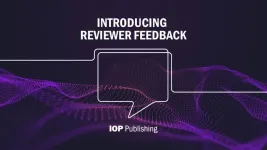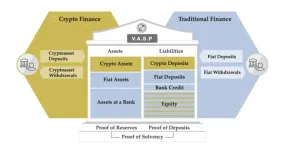(Press-News.org) Scientists at Université de Montréal’s Department of Chemistry have developed a new fluorogenic probe that can be used to detect and study interactions between two families of biomolecules essential to life: sugars and proteins.
The findings by professor Samy Cecioni and his students, which open the door to a wide range of applications, were published in mid-October in the prestigious European journal Angewandte Chemie.
Found in all living cells
Sugar is omnipresent in our lives, present in almost all the foods we eat. But the importance of these simple carbohydrates extends far beyond tasty desserts. Sugars are vital to virtually all biological processes in living organisms and there is a vast diversity of naturally occurring sugar molecules.
“All of the cells that make up living organisms are covered in a layer of sugar-based molecules known as glycans,” said Cecioni. “Sugars are therefore on the front line of almost all physiological processes and play a fundamental role in maintaining health and preventing disease.”
“For a long time," he added, "scientists believed that the complex sugars found on the surface of cells were simply decorative. But we now know that these sugars interact with many other types of molecules, in particular with lectins, a large family of proteins.”
Driving disease, from flu to cancer
Like sugars, lectins are found in all living organisms. These proteins have the unique ability to recognize and temporarily attach themselves to sugars. Such interactions occur in many biological processes, such as during the immune response triggered by an infection.
Lectins are attracting a lot of attention these days. This is because scientists have discovered that the phenomenon of lectins “sticking” to sugars plays a key role in the appearance of numerous diseases.
“The more we study the interactions between sugars and lectins, the more we realize how important they are in disease processes,” said Cecioni. “Studies have shown how such interactions are involved in bacteria colonizing our lungs, viruses invading our cells, even cancer cells tricking our immune system into thinking they’re healthy cells.”
Difficult to detect…until now
There are still many missing pieces in the puzzle of how interactions between sugars and lectins unfold because they are so difficult to study. This is because these interactions are transient and weak, making detection a real challenge.
Two of Cecioni’s students, master’s candidate Cécile Bousch and Ph.D. candidate Brandon Vreulz, had the idea of using light to detect these interactions. The three researchers set to work to create a sort of chemical probe capable of “freezing” the meeting between sugar and lectin and making it visible through fluorescence.
The interaction between sugar and lectin can be described using a “lock and key” relationship, where the “key” is the sugar and the “lock” is the lectin. Chemists have already created molecules capable of blocking this lock-and-key interaction, and can now to identify exactly what sugars are binding to lectins of high interest to human health.
“Our idea was to label sugar molecules with a chromophore, a chemical that gives a molecule its colour,” explained Cecioni. “The chromophore is actually fluorogenic, which means that it can become fluorescent if the binding of sugar with the lectin is efficiently captured. Scientists can then study the mechanisms underlying these interactions and the disturbances that can arise.”
Cecioni and his students are confident their technique can be used with other types of molecules. It may even be possible to control the colour of new fluorescently labelled probes that are created.
By making it possible to visualize interactions between molecules, this discovery is giving researchers a valuable new tool for studying biological interactions, many of which are critical to human health.
About this study
"Fluorogenic photo-crosslinking of glycan-binding protein recognition using a fluorinated azido-coumarin fucoside," by Cécile Bousch et al., was published Oct. 17, 2023 in Angewandte Chemie. Funding was provided by NSERC, the Fonds de recherche du Québec and the Canada Foundation for Innovation.
More on Samy Cecioni
Recruited by UdeM’s Department of Chemistry in 2019, Samy Cecioni is a young researcher specializing in the emerging fields of biological chemistry and glycomics. He is the recipient of a 2021 Medal for Research Excellence from UdeM’s Faculty of Arts and Science.
“Our lab develops new tools designed to accelerate discoveries in the field of glycoscience,” said Cecioni. “Scientists sometimes describe the molecules modified by sugars as the dark matter of biology because they are so difficult to detect. But we are shining a light on these interactions by adopting multidisciplinary approaches at the intersection of chemistry and biology, all with the aim of making significant advances in human health.”
END
Shedding new light on sugars, the “dark matter” of cellular biology
2023-11-14
ELSE PRESS RELEASES FROM THIS DATE:
Study sheds light on how Earth cycles fossil carbon
2023-11-14
HOUSTON – (Nov. 14, 2023) – As the primary element of life on our planet, carbon is constantly journeying from living creatures down into the Earth’s crust and back up into the atmosphere, but until recently, quantifying this journey was virtually impossible.
To help unravel the mystery of how the Earth cycles fossil carbon, Rice University’s Mark Torres and collaborators studied the chemistry of a river system extending from the Peruvian Andes to the Amazon floodplains. Together with collaborators from five other institutions, Torres helped show that high rates of carbon breakdown persist from mountaintop to floodplain, ...
High lung cancer rates in naval veterans linked to asbestos
2023-11-14
A University of Adelaide and Oxford University study has discovered asbestos exposure led to a higher incidence of asbestos-related lung cancers in British and Australian naval personnel than in other armed forces.
The data were collected from 30,085 United Kingdom and Australian personnel who served in the ’50s and ’60s, a time when asbestos-containing materials were present in British and Australian naval vessels.
Three of the four cohorts had previously been studied by the University of Adelaide and the UK Health Security Agency to identify the effects of radiation exposure from British nuclear testing; however, a raised incidence of mesothelioma, a cancer strongly linked ...
COP28: New study highlights need to address risk of continued global warming after net zero
2023-11-14
From scorching heatwaves to torrential downpours and devastating storms, the disastrous effects of global warming are sweeping across the world. Being the predicted outcome of burning fossil fuels, our best and only plan to limit warming is to reduce CO2 emissions from human activities to ‘net zero’ – where the amount of CO2 we emit into the atmosphere is equal to the amount we remove from it. To keep within the 1.5°C limit of the 2015 Paris Agreement, this needs to happen as soon as possible.
Though the ...
14-hour fasting improves hunger, mood and sleep
2023-11-14
Eating in a ten-hour window is associated with higher energy and mood and lower hunger levels, new results from the largest UK community science study of its kind shows1 .
Results from the trial are presented today by researchers from King’s College London at the European Nutrition Conference.
Intermittent fasting (IF), or restricting your food consumption to a set window, is a popular weight loss regime. A ten-hour window means limiting your daily eating schedule to ten hours and fasting for the ...
IOP Publishing unveils industry-leading feedback system for reviewers
2023-11-14
IOP Publishing (IOPP) is now offering peer reviewers feedback on their reviewer reports to enhance the quality of peer review and to strengthen best practice in the physical sciences.
IOPP have rolled out the new programme on an opt-in basis across all its proprietary journals. Where reviewers opt-in for feedback on their report, IOPP will share a numerical evaluation of how useful the report was to the in-house editors on a scale of 1 to 5, with 5 being outstanding and 1 indicating that ...
Assessing the solvency of virtual asset service providers: Are current standards sufficient?
2023-11-14
The collapse of FTX clearly highlights the importance of being able to evaluate the solvency of cryptocurrency exchanges. Currently, this is only possible to a limited extent. That's why researchers from the Complexity Science Hub (CSH), in collaboration with the Financial Market Authority (FMA) and the Austrian National Bank (OeNB), are now proposing a new approach.
Recently, a New York jury found Sam Bankman-Fried, the founder of the cryptocurrency exchange FTX, guilty of money laundering and fraud, among other charges. FTX was one of the largest trading platforms for crypto-assets and was valued at $32 billion before unexpectedly filing for insolvency in November ...
States with legalized medical marijuana see decline in nonmedical opioid use
2023-11-14
Medical cannabis legalization is associated with a decrease in the frequency of nonmedical prescription opioid use, according to a Rutgers study.
The study, published in the International Journal of Mental Health and Addiction, examined data from a nationally representative survey of adults who reported nonmedical prescription opioid use – or using prescription medications without a prescription or in a manner other than prescribed.
According to the study, when states implement medical cannabis laws, there is ...
Cancer stem cells trigger macrophage aging
2023-11-14
Cancer stem cells cause the aging of macrophages in mice with healthy immune systems, creating conditions for the formation of tumors.
Cancerous tumors consist of a mixture of cells, the most important of which are cancer stem cells. These cells are capable of establishing new cancerous tumors by evading the immune response. Research has focused on identifying biomarkers for cancer stem cells and developing therapies that target these cells. Unfortunately, candidate drugs developed from these efforts have so far not been very effective in clinical trials.
A research team led by Associate Professor Haruka Wada ...
New water treatment method can generate green energy
2023-11-14
Researchers from ICIQ in Spain have designed micromotors that move around on their own to purify wastewater. The process creates ammonia, which can serve as a green energy source. Now, an AI method developed at the University of Gothenburg will be used to tune the motors to achieve the best possible results.
Micromotors have emerged as a promising tool for environmental remediation, largely due to their ability to autonomously navigate and perform specific tasks on a microscale. The micromotor is comprised of a tube made of silicon and manganese dioxide in which chemical reactions cause the release of bubbles from one end. These bubbles ...
CPRIT recognized by TAMEST with Kay Bailey Hutchison Distinguished Service Award
2023-11-14
AUSTIN – TAMEST (Texas Academy of Medicine, Engineering, Science and Technology) is pleased to announce the Cancer Prevention and Research Institute of Texas (CPRIT) as the recipient of the Kay Bailey Hutchison Distinguished Service Award.
TAMEST is recognizing CPRIT for their work improving the lives of Texans, advancing cancer research and prevention, and recruiting National Academy members to Texas. CPRIT’s success in attracting top-tier cancer scientists and companies to the state ...









